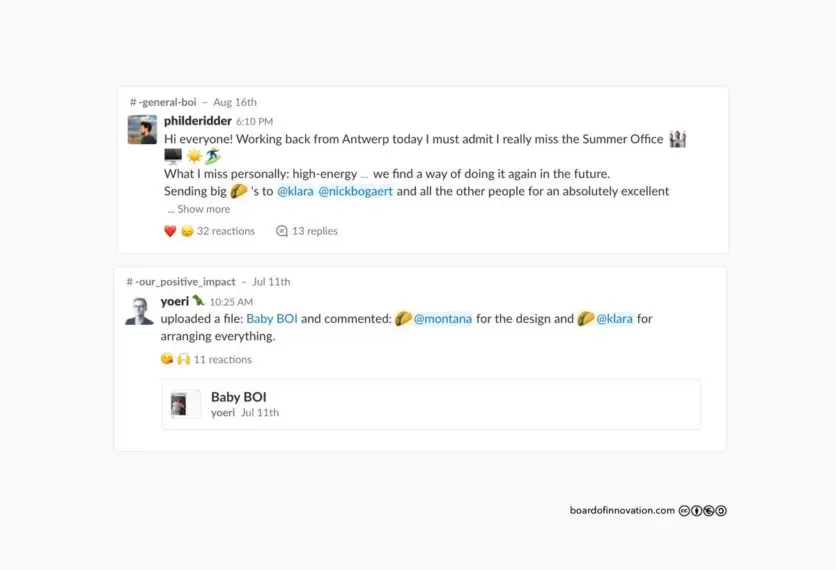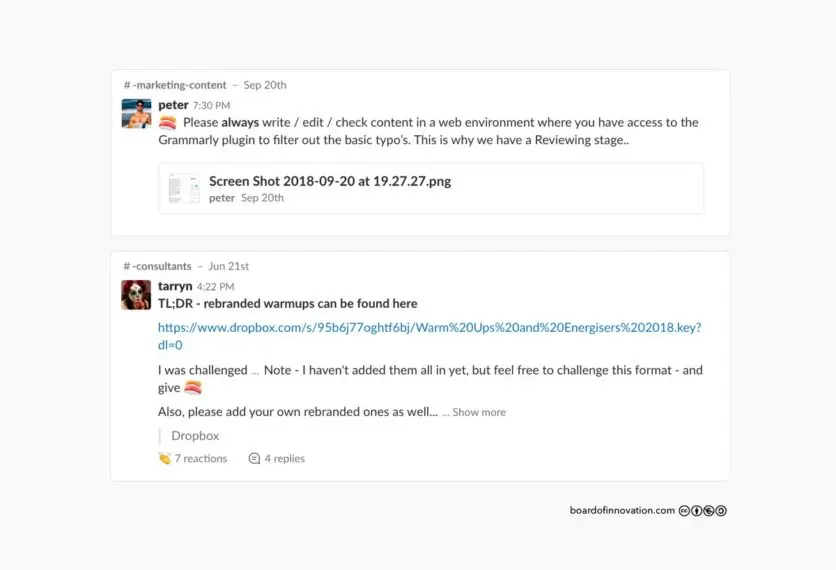Before joining Board of Innovation as a People & Culture Lead six months ago, I had already been working in the domain of ‘Human Resources’ for ten years.
I found out, most people hate feedback at work. And why wouldn’t they?
It’s often limited to the yearly, generally dreaded, performance reviews. And often, feedback is more of a weapon to justify (the lack of) wage increases, secure promotions or engage in office politics, rather than a true driver for personal and company growth.
However, multiple studies confirm, feedback (appreciative as well as more constructive feedback) works best when it’s something frequent, immediate, concrete, and comes in small portions.
As strange as this may sound, the most natural way of giving feedback is actually how we interact with children: we provide them with feedback all the time, with the purpose for them to grow. Imagine if we just had a bi-yearly sit-down with our child to discuss topics like taking off their shoes in the hallway, cleaning their plate, saying thank you properly, etc. That seems off, right?
So when I joined the company, I was happy to find an organization focused on building a strong direct-feedback culture.
Feedback food
“Feedback is the breakfast of champions” is a quote often attributed to Ken Blanchard. Well, when I started at Board of Innovation, I noticed an important part of Board of Innovation’s feedback culture actually also revolved around foods, often expressed in emoji:
- Tacos 🌮
- Burgers 🍔
- Sushi 🍣
Emojis were invented in Japan to express emotions that were otherwise hard or risky to express in person. In other words, they help as a communication tool when speaking to others about something emotionally complex or hard to deal with. That’s exactly the point of these symbols: each of the three emoji represents a way to deliver feedback. This simple practice enabled us to build a feedback culture we couldn’t have built otherwise with any performance scoring mechanism.
Tacos

When I joined, I got introduced to the tacos very quickly. Board of Innovation was already using it for a few years, and this practice had ingrained itself in our daily work.
On our Slack, we have a plugin that allows us to give tacos to each other (shoutout to HeyTaco!). Colleagues give each other a virtual taco as a way to congratulate or thank one another.
This has spread beyond Slack as well: at our monthly team meeting, we introduced a “taco-time” where we give credit to each other for the wins of the month. A few weeks ago, I even found a paper-folded taco on my desk, that appeared to be an anonymous appreciation letter.

I think our tacos are incredibly valuable. However, at some point, our “taco-culture” contributed to the creation of a conflict-avoidant culture: in other words, we were very prone to give appreciation, while we were less used to deal with conflict and disagreement. With ‘raise the bar’ as one of our core values, we need to focus on constructive criticism as well.
Burgers
So burgers came in. The meat here represents the criticism (the beef), while the buns around it represents the silver lining you use to cushion your critique.
Speaking in terms of burger allows colleagues to voice their individual need for balance between meat and buns. Some people prefer frank, direct and very clear constructive feedback (“forget the buns, just give me meat”), while others tend to always cushion feedback with a lot of bread. In case of mixed messages, this metaphor helps us to be explicit: “What’s the meat you’re giving me?”
Sushi

However, my all-time favorite is definitely the sushi, a concept introduced by two colleagues Giorgio and Nick in a Hack-My-Week challenge.
Sushi is raw fish, which here represents the raw, uncut feedback we give each other. And that sounds harsh, but it works out precisely because of the context of the sushi. It’s a symbol to emphasize that the feedback is given with nothing but good intentions. It helps people who are more conflict-avoidant and find it hard to give candid feedback. The aim of the sushi is to realize it isn’t meant to hurt anyone, but to point out areas of improvements, for both personal growth and company growth.
In online conversations, we add a sushi emoji before giving this type of feedback and it also has spilled out into offline conversations we have: sentences like “Can I give you some sushi on your presentation?” or “Can I go Japanese for a second?” have become the new normal. And who would ever say no to sushi, right? It creates a positive atmosphere around what is sometimes perceived as hard criticisms and it allows us to create a context in which we can be more candid.
Company culture is key
I can imagine, when you read this, it may sound gimmicky, like a startup culture which has gotten out of control. I can just say, in our case it really does work and has proven to be a key driver in pushing growth.
The key lesson here is that small, disarming daily things can help to shape a company culture and help build something bigger. The ‘feedback foods’ are of course incorporated in a broader feedback and company culture. In our self-steering teams, where we don’t have traditional bosses and managerial structures, other feedback key practices like monthly check-ins with your coach, quarterly all-to-all feedback rounds, and live pulse surveys, are all as much part of building and maintaining an open feedback culture.
Thoughts or questions? Feel free to reach out!
Has this post about tacos, burgers, and sushi made you hungry for our culture? We are hiring!


